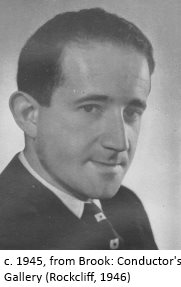
Of the
artists discussed so far in this series, Anatole Fistoulari is probably the least forgotten. As an unfailingly reliable concerto collaborator he was regularly called upon by both EMI and Decca from the late 1940s to the early 1960s. There must be few distinguished soloists of the time – from the elderly Mischa Elman to the young Vladimir Ashkenazy – with whom his name was not coupled at least once. His recordings of ballet music, too, were held up as models in their day and have never lacked admirers since. Paradoxically, this relative ubiquity has had a price to pay. Fistoulari is all too easily seen as part of the upholstery of the early LP era. Most people will have a few recordings conducted by him. Not so many will have stopped to ask who he was and of what his art consisted.
Perhaps my own curiosity derives from the fact that he was one of the first conductors I actually saw live, at the Leas Cliff Hall, Folkestone (Kent, UK). He conducted the Royal Philharmonic Orchestra in Tchaikovsky’s “Romeo and Juliet”, the Mendelssohn Violin Concerto, with Steven Staryk, and Brahms’ First Symphony. My recollection is of a fairly dapper figure with an undemonstrative stick technique particularly strong on rhythm – though expression was nevertheless obtained. I was sitting near the front and could see that he added some rhythmic mouthing at the brass in key moments. And in fact, precise articulation and energetically braying brass in a typically Russian way are constant features of the records examined below. While Tchaikovsky was obviously home territory to him, I was truly bowled over by his Brahms. But these are teenage memories and I cannot rule out the possibility that any half-way decent performance of that symphony – which I was hearing live for the first time – would have knocked me for six. Unfortunately, I have no way of testing my memory against his recording of the work, since he made none.
One curiously exhibitionist feature I remember of an otherwise workmanlike technique is that, on the last forte chord of a work, he would sometimes cause his baton to vibrate, almost like a side-drum player’s roll. I spent much time with the baton in my school’s music room trying to make a similar vibrato and I still don’t quite see how he managed it.
A strange episode belongs to the concerto performance. Steven Staryk, after a brilliant career as leader/concertmaster of at least three great orchestras, had just launched himself as a soloist. Readers will readily recall that the Mendelssohn is exceptional among the classical concertos for the way in which the soloist enters after just a bar and a half of orchestral mood-setting, instead of after a long introduction. Soloist and conductor having taken up their positions, Fistoulari looked enquiringly at Staryk, who had tucked his violin under his arm and was benignly studying the ceiling with the air of one who has nothing to do for at least five minutes. Fistoulari looked away, then looked back with a slightly puzzled expression. Staryk gave him a brisk nod, as though to say “What are you waiting for? Get on with it”. Fistoulari blinked, semi-shrugged his shoulders with an air of “All right, if that’s how he wants it” and started. Staryk raised his violin at exactly the last moment and entered perfectly.
I have always assumed this was a gag. I did, however, encounter a recent discussion in which it was recalled that a violinist had described in his memoirs how he had come onto the platform convinced he was to play the Beethoven and, hearing the opening bars of the Mendelssohn, just managed to get the violin under his chin in time. Nobody could remember who the violinist was, so I suppose it could have been Staryk. More likely, however, he was imitating an episode that happened to a more famous colleague. At least he ensured that I remembered his performance – but only for that.
The following brief account of Fistoulari’s career derives from two sources: the chapter in “Conductors’ Gallery” by Donald Brook (Rockliff 1946) and the obituary by John Amis (The Independent 22 August 1995). The former seems to have been based on an interview with the conductor but, for obvious reasons, covers only his early career. John Amis had considerable contacts with Fistoulari in his post-war years in London, but evidently drew upon Brook for the earlier period.
Pre-war
Anatole Grigorievich Fistoulari is always described as Russian and presumably thought of himself as such. In view of recent political events he should perhaps be called Ukrainian, since he was born in Kiev on 20 August 1907. At the age of seven he conducted a performance of Tchaikovsky’s “Pathétique” Symphony from memory. Regular appearances followed and a “well-known critic” in Odessa wrote that “Uncanny memory, extraordinary rhythmic sense and overpowering will, unknown in a child of his age, make him an entire master of the orchestra – these are the qualities that give a promise of this child becoming a truly great artist”.
At the age of 13, in 1920, he conducted Saint-Saëns’ “Samson et Delilah” at the Bucharest Royal Opera House. A period in Germany followed, where he was advised and encouraged by Nikisch. In 1933 he was engaged to conduct a series of opera performances with Chaliapin. At the first rehearsal of “Boris Godunov” the celebrated bass declared: “I have been singing ‘Boris Godunov’ for forty-one years, but this is the first time I have said ‘bravo’ to the conductor at the first rehearsal”. As Amis remarked, “If you could follow Chaliapin, you could follow anybody”.
Fistoulari’s particular association with ballet was made concrete by his work with Massine’s Russian Ballet in Monte Carlo. This led to tours of London (Drury Lane and Covent Garden), America (New York Metropolitan and sixty-five other cities) and Europe, including an appearance at the Florence May Festival attended by the Princess of Piedmont. At his last concert before the Second World War, with the Orchestre de la Société Philharmonique de Paris, President Lebrun was among the audience.
The war years
On the outbreak of war, Fistoulari enlisted with the French army, but was invalided out in 1940 and fled to England. Arriving penniless, he sold his watch to make the journey from Southampton to London. Here he met another refugee, Mahler’s daughter Anna. They were married on 3 March 1943 and their daughter Marina was born on 1 August of that year. Older reference books, anchored in Victorian morality, tend to glide over the vicinity of these dates. Fistoulari was Anna’s fourth husband – a fifth was yet to come. They were separated in the early 1950s – by 1952 Anna was living in California – though the marriage was not dissolved till about 1956.
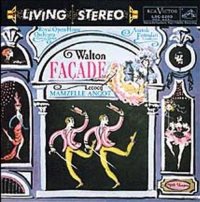
In 1941, Fistoulari conducted a highly acclaimed series of performances – over 200 including a provincial tour – of Mussorgsky’s “Sorotschinsky Fair”. The cast included Oda Slobodskaya, Otokar Kraus and Parry Jones and the proceeds from one of the earlier performances went to Mrs. Churchill’s Aid to Russia Fund. His first symphony concert in England was in March 1942. Ida Haendel was the soloist. On 24 October 1943 he gave the first British performance of Shostakovich’s Sixth Symphony. He spoke to Brook of his great admiration for British composers, mentioning “Purcell, Elgar, Bliss, Vaughan Williams and William Walton, and he believes that Benjamin Britten has a great future”. As far as I am aware, the only recorded evidence of this interest is the two suites from Walton’s “Façade”.
In 1943 Fistoulari was appointed principal conductor of the London Philharmonic Orchestra with a contract to conduct 120 concerts during his first season. It was unrealistic on both sides – how many concerts per season have more recent incumbents been required to give? With a mainly operatic and ballet repertoire behind him, Fistoulari was reduced to swotting up the scores overnight, “conducting” other conductor’s records in front of the mirror. While some of his performances – of the works he already knew well – were said to have been impressive, not least that of his father-in-law Mahler’s Fourth Symphony, his inevitably superficial knowledge of much of the music he was conducting alienated the orchestra. His contract was not renewed. As Amis notes, the LPO’s 50
th anniversary booklet in 1982 omitted his name from their list of principal conductors. The only reference to him you’ll find on the LPO’s current site is to the Shostakovich 6 première. The Wikipedia article on the LPO similarly excludes him. In 1956 Sir Adrian Boult was more magnanimous, having Fistoulari conduct some of the orchestra’s concerts during their tour of the Soviet Union, the first ever by a British orchestra. Russian archival recordings from this tour appear to survive. A CD was issued in which Fistoulari conducts Mozart’s 40
th Symphony, alongside with Boult items that add nothing new to his discography (Berlioz and Holst).
Post-war
In spite of the failure of his LPO conductorship, Fistoulari remained in England, becoming a British citizen in 1948. He formed a pick-up band, the London International Orchestra, with which he toured the provinces. Apart from this he had no further permanent appointment. He worked regularly in the recording studios over the next decade or so, accompanying famous soloists, setting down some celebrated ballet recordings and a few other orchestral works, mostly shorter and lighter Russian fare. As well as his sessions with EMI and Decca he set down material for smaller companies such as Mercury, Everest, Vanguard, MGM and Remington. In the 1970s Decca revived their interest in him for their Phase Four series, including Tchaikovsky’s Fourth Symphony and a further complete “Swan Lake”. Perhaps Fistoulari was now past his best. These recordings were not especially well received. In later years he apparently suffered much from arthritis. It is not entirely clear when he actually retired. Like many artists who slowly fade from view, perhaps he never formally retired – the engagements just stopped coming. His second marriage, to the Scottish violinist Elizabeth Lockhart, seems to have been a happy one. He died on 21 August 1995.
At the time of his interview with Brook, Fistoulari was living “in a spacious flat in Kensington, which is furnished artistically in a light, modern style”. A little later, Amis reported him as “living a hand-to-mouth existence but always putting on a show of some grandeur”. Perhaps the break-up of his marriage to Anna Mahler led to a decline in living standards. Less easily compatible is Brook’s claim that “His English is excellent, but it is not without traces of a Russian accent” with Amis’ recollection that “His English remained rudimentary”.
The recordings
As always in this series, I am extremely grateful to the generous-minded bloggers who have made available for download so many out-of-print recordings that would otherwise probably have remained inaccessible for ever. As these blogs come and go, I shall limit myself again to a general list of blogs where Fistoulari material can be found: Random Classics, ReDiscovery, The European Archive, The Music Parlour and Yayo Salva. It should be added that at least some Fistoulari performances can be obtained through modestly-priced downloads or as CDs from smaller companies specializing in such reissues. The later Phase Four recordings, of course, are still under copyright.
Violinists
Though Elizabeth Lockhart (1921-1999) never achieved any great reputation as a violinist, the couple can be heard together – a little before their marriage – in
Chausson’s Poème and
Ravel’s Tzigane. In the former, Fistoulari interprets Chausson’s sultry atmospheres with great insight. Lockhart was obviously a very good violinist. Her slides in her first entry are fascinating. In the more virtuoso passages she does not tear away – a live performance by Kogan with Chalabala conducting shaves more than two minutes off Lockhart’s timing – but she is confident enough to make you feel she means it that way. All the same, while one takes the point that Lockhart’s Ysaye-like sweetness may be closer to what Chausson had in mind than Kogan’s Slavonic throb, hers is primus-inter-pares playing where virtuoso self-glorification sometimes seems in order.
Lockhart copes nobly with the fiendish difficulties of the Ravel. Yet a comparison with, for example, a sure-fire virtuoso like Ruggiero Ricci (with Ansermet on Decca) shows what is missing. It is not just that Lockhart is slow – though she does take two minutes longer. This wouldn’t matter if there was real tension, but she just plods on hopefully, albeit competently, from one moment to the next. In truth the Ricci performance seems not just two minutes shorter, it seems about half the length and it makes sense of a piece that not everybody rates among Ravel’s successes. No complaints about Fistoulari’s conducting of the Philharmonia Orchestra. There does seem an extra magic from Ansermet, but given the abyss between the two soloists it seems unkind to presume that Fistoulari could not have provided the same if a soloist like Ricci had been playing. I have traced no other records by Lockhart, with or without Fistoulari (
MGM E3041).
Ricci, by the way, was the soloist in Fistoulari’s last “Swan Lake” recording. Fistoulari also partnered him in the
Khachaturian Concerto. The circumstances surrounding the involvement of
Alfredo Campoli in Fistoulari’s first “Swan Lake” are related below. Campoli also joined Fistoulari and the “New Symphony Orchestra” in two charmers by
Saint-Saëns, the
Havanaise and the
Introduction et Rondo Capriccioso. The violinist’s nudging rubatos, sweet tone, elegance and, where required, virtuoso dash could not be better applied than here. The orchestra is strictly an accompanist, but Fistoulari is spot on (Decca
LW 5085, 1954).
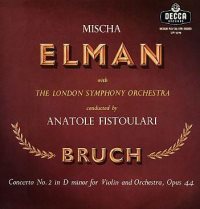
Another violinist of the “old school” was
Mischa Elman, whom Fistoulari accompanied, with the London Symphony Orchestra, in
Bruch’s Violin Concerto no.2. The violinist and conductor seem to have set themselves the task of persuading the listener that Bruch 2 is actually better than the familiar Bruch 1. And as far as I am concerned, they come damn near to succeeding. This is undoubtedly a violinist of yesteryear, taking his time over the lyrical portions, and also an elderly violinist, sometimes scrambling the virtuoso passages, which is preferable to slowing them down, sometimes sliding more than a modern violinist would. Yet his warm, lustrous sound, so human, so vocal in its phrasing, so sweet and caressing, has you thinking that this must be something like the sound of Sarasate which Bruch had in mind. Fistoulari is no less inspired, conjuring louring proto-Sibelian textures from the first movement and finding a wonderful passion in, for example, the second theme of the finale. A classic that got away (Decca
LW 5920).
It appears that the Mendelssohn concerto was set down at the same sessions, but never released. Two violin concerto collaborations for EMI were with
Yehudi Menuhin (
Paganini: Concerto no.2) and
Nathan Milstein (
Brahms Concerto, Saint-Saëns Third Concert, Chausson Poème). A review of the Brahms by David Billinge can be found
here.
Pianists
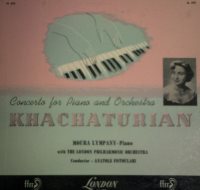
The earliest of Fistoulari’s concerto recordings with a pianist must surely be the
Khachaturian Piano Concerto, which was set down with
Moura Lympany and the London Philharmonic Orchestra in May 1945. It would seem to have been the first recording of this work, slightly predating the version by Kapell and Koussevitzky. This recording is available from Dutton. Rather better known, though, is the same team’s remake of October/November 1951, which served well down the years on Ace of Clubs. I have already discussed this recording in my article on
Hugo Rignold, where I felt that the Katin/Rignold recording on Everest brought off a similarly mercurial approach rather better – Lympany sounds a little effortful in comparison.
Also on late 78s was
Mendelssohn’s Piano Concerto no.1, in which Fistoulari and the London Symphony Orchestras partnered
Eileen Joyce. The recording makes Joyce sound very bangy at the beginning. Perhaps she took a couple of minutes to settle down, or maybe the engineers needed the time. Whatever, from about a third of the way through the first movement she’s providing an ideal combination of bubbling vivacity and gentle poetry. Fistoulari’s orchestra comes across very well, with a stylish post-Mozartian, pre-romantic elegance, enough to cause regret we don’t have one of the symphonies, or at least an overture or two, from him (Decca K 1687-8, 1947).
Other well-remembered collaborations are with
Clifford Curzon in the
Grieg Concerto,
Julius Katchen in
Rachmaninov’s Second Concerto (both for Decca),
Earl Wild in the
Tchaikovsky Concerto (for Readers’ Digest) and the young
Vladimir Ashkenazy’s first recording of
Rachmaninov’s Third Concerto. Some critics still prefer this above Ashkenazy’s later recordings, though it uses the then-current cut text which Ashkenazy himself was among the first to jettison only a few years further on. A 1949 Paris performance of
Beethoven’s Fourth Concerto with
Edwin Fischer has also surfaced on Music and Arts. For EMI, Fistoulari partnered
Shura Cherkassky in
Liszt’s First Piano Concerto while, back on Decca, he joined
Wilhelm Kempff in an atypical – for the pianist – but highly successful, even revelatory traversal of both
Liszt Concertos. I
reviewed this for MusicWeb-International back in 2003.
Particularly interesting, since they regard repertoire in which we rarely hear Fistoulari, are five discs made in 1952 or 1953 with
Fabienne Jacquinot. Jacquinot was a prize-winner at the Paris Conservatoire at the age of fifteen and a pupil of Yves Nat. She was touring widely by the mid 1940s and this series of records seems to have been the result of a tour she made of Spain with Fistoulari conducting. Jacquinot subsequently withdrew from the concert scene but made some sort of a comeback in the 1980s. She was acting on competition juries until at least 2007.
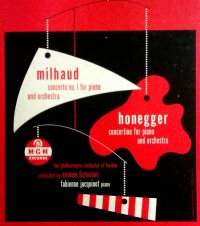
The
Honegger Concertino and the
Milhaud Piano Concerto first came out on a 10-inch LP and were later recoupled with the two Lockhart recordings. I’ve already discussed the Honegger in my article on
Georges Tzipine. As I said there, Monique Bérard and Tzipine express unhurried enjoyment, while Jaquinot and Fistoulari, conducting the Philharmonia Orchestra, are swifter (09:31 compared with 10:52). Though certainly not frenetic, they are smoochier, more streetwise, ironic. It’s difficult to find one preferable to the other, or even know which Honegger himself might have preferred.
In the Milhaud, Fistoulari proves a dab hand at this kind of French music. He is at one with the pianist in finding the slightly fussy, bubbling-champagne vivacity in the outer movements that sounds oh-so-French, while in the slow movement the long lyrical lines are cool yet expressive. Moreover, he proves a master of balance. Milhaud’s busy counterpoint can so often turn into a slanging match between the instruments. Fistoulari sees to it that the lines we need to hear are well forward, with the secondary lines firmly relegated to their proper place. Maybe this is one of Milhaud’s better efforts anyway – it certainly sounds highly attractive here (
MGM E3041).
In
Saint-Saëns’ Fifth Piano Concerto, Jacquinot shows virtuoso flair without barnstorming and a free-flowing approach that never betrays the essential elegance of this composer’s work. Fistoulari sticks to her like a limpet. On this record, which also contained
D’Indy’s Symphonie sur un Chant Montagnard, Fistoulari conducts the “Westminster Symphony Orchestra”, apparently the Royal Philharmonic playing out of contract (
MGM E3068).
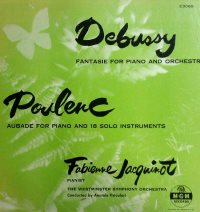
The “Westminster Symphony Orchestra” also plays in a pairing of the
Debussy Fantaisie with
Poulenc’s Aubade. Jacquinot and Fistoulari make an unusually strong case for the Debussy, presenting it as a heady brew of fin-de-siècle euphoria with latent, even seething passion and coursing vitality as well as evanescence. In the Poulenc they are punchy, pacy and impudent as required.
With the Philharmonia Orchestra, Jacquinot and Fistoulari set down
Rimsky-Korsakov’s Piano Concerto with
Liszt’s Totentanz (
MGM E3045) and
Richard Strauss’s Burlesque with the
Dohnanyi Nursery Rhyme Variations (
MGM E3004). These numbers may refer to the American issues. The records seem to have been released by Parlophone in the UK.
Even rarer repertoire was set down with
Felicia Blumenthal – works by
Paderewski and
Tavares. The latter has been issued on the Blumenthal-dedicated Brana label and was welcomed with slight bemusement by
Rob Barnett.
What may have been Fistoulari’s final visit to the recording studios was a 1979 collaboration with
Ilana Vered and the Philharmonia in
Brahms’ Second Piano Concerto. This was a Decca Phase Four issue. By such a quirk as only Internet could produce, it is possible to hear the first and last movements, sandwiching the second movement played by Elizabeth Leonskaja and the Quartetto Italiano playing the third movement of one of Brahms’ string quartets. I am not sure whether the person who put the tracks up intended this or whether it just happened. On this partial evidence, the performance sounds extremely interesting. Tempi are leisurely and Vered, while commandingly present in the big moments, drifts into moments of great intimacy and, I must say, lots of liquid tone. Fistoulari’s phrasing is very detailed and he uses the slow tempi to draw a gracious, very Brahmsian timbre from the orchestra. In the big tuttis he manages to keep the textures lean in spite of the broad gait. I hope I shall hear this complete one day, since these two movements suggest it’s a sleeper among Brahms Seconds and, just to stay with the Decca catalogue, rather more interesting than the frequently reissued Ashkenazy/Haitink.
Mainly shorter orchestral pieces
At the outset of his recording career, in around 1944, Fistoulari set down
Beethoven’s Seventh Symphony and
Schubert’s Unfinished with the National Symphony Orchestra. The Gray catalogue, viewable at the CHARM site, also lists single movements from Beethoven’s Fifth, Mendelssohn’s Italian, Tchaikovsky’s Fourth and Dvořák’s New World. However, this catalogue seems to list all sessions whether issued or not, so it is not clear whether these were intended to remain isolated movements or whether they were abortive, unreleased attempts at the complete works. The Schubert was issued by Beulah not so long ago. Bob Briggs found it
dramatic. From a substantial extract (about the last two-thirds of the second movement) available on Internet I would agree. The tempo is broad, but the phrasing is very detailed and there is a sense of slumbering drama.
Despite these beginnings, when working without a soloist Fistoulari was invariably typecast as a ballet conductor. Even such non-ballet pieces as he was allowed to set down post-war, and which I shall discuss first, tend to be pictorial in nature rather than symphonically developed. A clutch of EMI and MGM recordings has him conducting fairly rare concert works by
Glazunov, Rimsky-Korsakov and
Tchaikovsky, and suites from operas by the latter two of these.
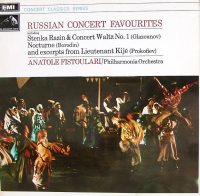 Glazunov’s Stenka Razin
Glazunov’s Stenka Razin, with the Philharmonia Orchestra, is frankly terrific. From the misty, dawn-on-the-Volga opening to the passionate climaxes, Fistoulari gets the sort of all-out response we associate with Russian conductors, and indeed Russian orchestras. There’s the sort of controlled brinkmanship we know from the likes of Mravinsky, with chattering woodwind and braying brass. Yet, while it’s a vehemently committed interpretation, it’s not indulgently personalized – Fistoulari keeps a strong grip on the structure.
The same composer’s
Concert Waltz no.1, on the other hand, again with the Philharmonia, has a wonderful, smiling yet melancholy grace, somehow deeply Russian. Franz André, with the Belgian National Radio Orchestra on Telefunken, at a faster tempo, and with occasionally scrambled playing, brings it the verve of the “belle époque”. By a whisker I prefer Fistoulari, though the competition is unfair – he has an excellent recording, André’s is rather muffled and old-sounding. A future article in this series will be dedicated to André.
On hearing of the existence of a mature 16-minute tone poem by
Rimsky-Korsakov called
Skazka
(“A Fairy Tale”), one is bound to wonder why it is so little heard. When it does turn up, it proves a somewhat lukewarm, uninvolving piece, with even the composer’s famed orchestral wizardry only partially evident. This doesn’t seem to be Fistoulari’s fault, since he is precise, vital and as colourful and expressive as circumstances allow. He doesn’t convince one that the music is better than it is, but neither does he miss such opportunities as it presents. This, too, is played by the Philharmonia.
Far more impressive is the suite from Rimsky-Korsakov’s
Ivan the Terrible. In itself, the music might seem a little short on this composer’s most endearing qualities, but here Fistoulari seems out to convince us otherwise in a truly riveting interpretations. Seething vitality and raging brass alternate with piquant poetry and, in the second intermezzo, slumbering menace. This is the real Russian article. The orchestra here is the London Symphony.
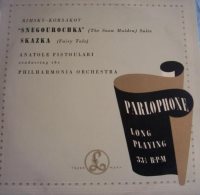
The Philharmonia is back again for a suite from Rimsky’s
The Snow Maiden. Despite the presence of the famous “Dance of the Tumblers” – driven along with a fine whirl of excitement – this opera, more highly reputed than Ivan the Terrible, seems less impressive in these excerpts. Fistoulari is cool and crisp, but affectionate too in his strict tempo way.
One further Rimsky offering, this time with the Royal Philharmonic, is the
Procession of the Nobles from
Mlada. This brassy little piece gets a suitably upfront performance. The recording is almost garishly brilliant. Quite recently Jonathan Woolf discussed a
Guild reissue of “Russian Concert Favourites” under Fistoulari which included this Mlada extract and the two Glazunov pieces – his enthusiasm matches my own.
Of
Tchaikovsky’s three Shakespeare-inspired orchestral pieces,
The Tempest is certainly the rarest. Fistoulari gives a very well shaped, vital performance of this rather disappointing piece. He makes the most of its best moments – the opening will always have the listener wondering if it might turn out to be a masterpiece after all. If it is possible, by sheer gut conviction, to make the music seem truly inspired – I suspect it is not – then Fistoulari does not quite manage this.
Tchaikovsky’s opera
Vakula the Smith (aka The Slippers) is as little-known as his Tempest fantasy. It is, on the strength of Fistoulari’s orchestral suite, much more interesting. This is “nationalist” Tchaikovsky, closer to Rimsky-Korsakov than usual. Fistoulari responds with his usual crisp vitality, while the better music draws fuller engagement from him. The orchestra for both these Tchaikovsky items is the Philharmonia. Fistoulari actually recorded all three of Tchaikovsky’s Shakespeare pieces – he set down
Romeo and Juliet and
Hamlet, with the Philharmonia, for MGM in around 1953 (
MGM E3002).
Further Fistoulari recordings of concert pieces include six
Liszt Hungarian Rhapsodies for Vanguard,
Liszt’s Les Préludes and
Tasso for MGM,
Grieg programmes for both EMI and MGM,
Balakirev’s Tamar (MGM),
Glinka’s Kamarinskaya, Valse-Fantaisie and a suite from
Russlan and Ludmila (MGM),
Borodin’s Nocturne (MGM),
Ippolitov-Ivanov’s Caucasian Sketches coupled with a suite from
Glière’s The Red Poppy (RCA), a disc of overtures –
Nicolai’s The Merry Wives of Windsor,
Reznicek’s Donna Diana and
Rimsky-Korsakov’s May Night (MGM),
Fauré’s Dolly Suite (MGM) – and more
Tchaikovsky: Francesca da Rimini and the
Theme and Variations from Suite no. 3 for Remington, with the Berlin RIAS Orchestra, the
Mozartiana Suite for MGM, the
March from Suite no.1 (EMI) and the Decca Phase Four recording of the
Fourth Symphony. This list does not claim to be complete.
Opera
The orchestral suites discussed above suggest that Fistoulari knew and loved the Russian operatic repertoire. But, quite simply, his post-war career did not embrace opera. Some inkling of his capacities in the pit can be gleaned from his collaborations with
Inge Borkh,
Boris Christoff,
Victoria de los Angeles, Margherita Carosio and
Jan Peerce – the latter in a programme of Neapolitan songs. Various tracks from these discs have found their way onto anthological CDs dedicated to the singers.
Some further evidence may be gleaned from two orchestral anthologies. These contain mainly ballet music from operas, though the earlier of them, set down in Paris with the Conservatoire Orchestra in February 1950, actually starts with the overture to
Ambroise Thomas’ Mignon.
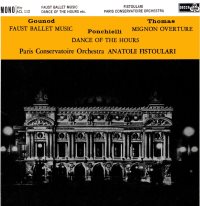
You would hardly believe that this “simple” piece could yield such different, yet equally convincing, approaches as those of Fistoulari and Franz André with the Belgian National Radio Orchestra. Go to André for an introduction suffused with proto-impressionist poetry and
douceur, with a wonderfully tender – but vibrato-laden if that’s a problem – rendering of the “Connais-tu le pays” melody by the horn. Go to Fistoulari to hear the introduction played with raw tension and “Connais-tu le pays” – equally vibrato-laden – simply dripping with emotion. It seems to have strayed in from Tchaikovsky’s “Manfred”. Come the lively music and André nudges in with a wink, keeping it all light and effervescent, perfect
opera-comique. Fistoulari drives it to the brink of hysteria, with whiplash attack and feverish energy. You might say that André is closer to Thomas as an exponent of the
belle-époque, while Fistoulari has extracted something closer to Goethe’s own world.
This disc continues with
“The Dance of the Hours”, from
Ponchielli’s La Gioconda, a piece Fistoulari had previously set down with the National Symphony Orchestra in 1944 (
Decca K 1119). There are no particular differences between the two versions. Both times Fistoulari combines balletic spring with a certain toughness and tension well-suited to a contemporary of Verdi. However, around the third section the Paris performance takes wing rather more, concluding with higher adrenalin levels. It would seem, in fact, that Fistoulari invariably obtained a particularly alert response from the Paris orchestra.
Striking, too, is the
Ballet Music from
Gounod’s Faust. The last section shows why Fistoulari was such a successful ballet conductor, both with the dancers themselves and with the public. He holds a strict tempo, which with some ballet conductors means a less-than-enthralling interpretation musically. But Fistoulari has it both ways. There is rhythmic verve at the opening, with a sense that he is pushing tempo and dynamics as far as they can go without embracing hysteria. And then the soaring string theme wells out passionately without any slackening of the pace, yet with expressivity to set your blood boiling. In general, Fistoulari’s conducting of this music is not graceful and elegant, à la Beecham, but colourful and ardent. If anyone thinks Gounod is hardly the composer to engage the emotions, especially when writing dance music, Fistoulari would seem not to agree.
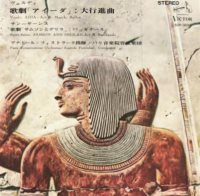
About a decade later came a stereo disc, again with the Paris Conservatoire Orchestra, that cast its net a little wider. It starts with the
Dance of the Moorish Slaves, March and
Ballet from
Verdi’s Aida, a slightly cobbled-together sequence pretending to make for continuous listening. The Dance of the Moorish Slaves has verve and elegance but rather lacks Verdi’s strong primary colours. A scrap of the Triumph Scene, in which the unique timbre of erstwhile French brass substitutes the chorus, leads to the March, a real vibrato-Fest at a buoyant tempo. The Ballet makes it all worthwhile. It’s faster than usual, with terrific articulation and dynamic contrast, and all the barbaric oriental splendour that Fistoulari seemed to be missing earlier on.
Next comes the
Bacchanale from
Saint-Saëns’ Samson et Dalila. Fistoulari builds the piece to a sizzling conclusion but without indulging it along the way, and even maintaining a touch of Gallic elegance. It must be said, though, that he seems a bit staid alongside the lurid orgy that Hans Swarowsky whips up – a future article will discuss this.
Even further from Fistoulari’s home territory would appear to be the
Passo a sei and
Soldiers’ Dance from
Rossini’s Guglielmo Tell. In truth, a finer tribute to the conductor’s rhythm would be hard to imagine. Jaunty, infectious, elegant and, in the last stages, simply fizzing, yet never overheated, this is the spirit of Rossini.
And lastly, the
Dances of the Persian Slaves from
Mussorgsky’s Khovanschina give the lie to any impression that Fistoulari was primarily a rhythmic conductor. The opening is beautifully atmospheric, with gently nudging rubato. Infectious rhythm takes over, but still with space for a certain sultry elegance (
RCA RB 16221/SB 2094, reviewed by EMG Monthly Letter 1/60).
Ballet
Fistoulari’s complete version of
Delibes’ Sylvia with the LSO on Mercury (
MMA 11036-7/AMS 16032-3, reviewed by EMG Monthly Letter 8/59 and 5/60) is famous. So, too, is that of Adam’s Giselle with the same orchestra for the same company (
MMA11141-2/AMS 16087-8, reviewed by EMG Monthly Letter 1/62). Slightly later, in 1964, came suites from
Delibes’ Coppélia and
Sylvia with the Royal Philharmonic Orchestra for Readers’ Digest. Predating these, I presume, is a suite from the latter set down for Remington with the Berlin RIAS Orchestra. And it’s gorgeous. The fruity horns might have come from Paris but the discipline is Germanic. Fistoulari’s response to phrasing, dynamic shading and balance is exceptionally detailed, combined with elegance, grace, vitality and subtle rubato. In its undemonstrative perfection, this is actually quite sensational.
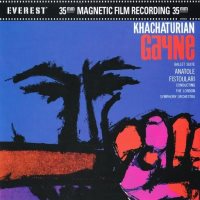
Pretty spectacular in every way, too, was his suite from
Khachaturian’s Gayaneh. The wodge of recordings set down on film for the Everest company, mostly in Walthamstow Town Hall around 1959, is returning to amaze us. Originally heard in the UK on subfusc World Record Club transfers and later on gritty Everest LPs, their time is coming at last. For colour, range, clarity and a natural acoustic, you could kid most listeners this is a recent recording.
Conducting the London Symphony Orchestra Fistoulari provides, for his part, superb rhythmic control that serves as a background to finely sculpted phrasing and bright primary colours. The strict-tempo approach to ballet music that isn’t as good as Tchaikovsky’s or Prokofief’s has its downside, though, and I wondered at times if an occasional freshening up of the tempo during the some of the dances, however unwelcome it would be to the ballerinas, might have injected a semblance of interest into music that is fast running out of that commodity. Terrific as this is, in one sense, I can’t say it makes the music sound any better than it is. Those who find the music inherently worth listening to should find the performance above criticism.
I see that a few internet commentators have found the Sabre Dance too brisk. I can’t say I had any difficulties with it, maybe because the last time I heard it was in the VPO/Silvestri rendering, which is a few seconds faster still (Everest
SDBR 3052, rec. Walthamstow Town Hall 1959).
Going back to the earlier days of LP, Fistoulari’s version with the New Symphony Orchestra of the
J.Strauss/Dorati confection “
Graduation Ball” was judged by Edward Sackville-West and Desmond Shawe-Taylor’s hard-to-please “The Record Guide” (1955 edition) “An unqualified success – some fifty minutes of gay, tuneful music, beautifully played and perfectly recorded” (Decca LXT 2848). Other Fistoulari ballet offerings include suites from
Lecocq’s Mam’zelle Angot, with the Royal Opera House Orchestra (coupled with the Façade suites on
RCA LSC 2285) and
Luigini’s Ballet Egyptien (with the Royal Philharmonic on HMV ER5128).
Poulenc’s Les Biches was set down for MGM.
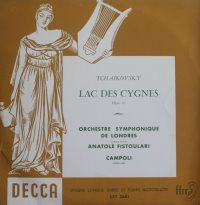
The hard core of the ballet repertoire is nevertheless
Tchaikovsky. Fistoulari set down two “complete” recordings of
Swan Lake, with the London Symphony Orchestra in 1952 and with the Netherlands Radio Symphony Orchestra in 1973. In between, in 1961, he recorded 46 minutes of highlights with the Amsterdam Concertgebouw Orchestra. I put “complete” in inverted commas advisedly. What the “complete” Swan Lake actually consists of is something of a dog’s breakfast. Fistoulari’s 1952 version lasts about 90 minutes. The 1973 recording takes 157 minutes, so presumably inverted commas are not needed. Some of the extra music is actually by Minkus, not by Tchaikovsky, but then, some of what remains is not by Tchaikovsky either but by Drigo. And some of the real Tchaikovsky is orchestrated from his piano pieces, so was not really intended for the ballet. All this, however, is not mere caprice on the part of Fistoulari. The 1952 recording preserves – and is alone in doing so – the score as danced at Covent Garden in the 1950s. So, however “inauthentic”, it has a certain interest for ballet lovers.
Another oddity of the 1952 set is that it was originally recorded with the violin solos played by the LSO’s leader at that time, George Stratton. However, the producer, John Culshaw, didn’t like Stratton’s tone and had the solo parts remade with
Alfredo Campoli. Stratton resigned from the orchestra in protest and died soon afterwards, one hopes not for that reason. Fistoulari’s Concertgebouw extracts had the solos played by the orchestra’s leader, but since this was the distinguished Stephen Staryk, the producer – Ray Minshull – presumably had no grounds for complaint. In 1973 another celebrated artist of Italian ancestry was brought in – Ruggiero Ricci.
The 1961 extracts also have a story attached to them. Georg Solti’s recording of Mahler’s 4
th Symphony had finished ahead of schedule, leaving Decca with two full sessions booked. One of Fistoulari’s most memorable records therefore came into being by pure chance.
I do not know the 1973 recording. My rapturous review of the 1961 highlights can be found
here. The LSO version is less fine in so far as the recording is older and in mono. This is a problem only if you go back and forth between them. Comparisons of this kind also reveal that the LSO, excellent as it was, was not quite in the Concertgebouw class. The solo oboe, in the famous swan theme, is rather thin in London, for example.
Enough complaining. In tempi, characterization and articulation the 1952 performance is exemplary. It also has plenty of vitality, colour and passion. It is only on turning to the Concertgebouw extracts that one realizes that Fistoulari could have stretched his orchestra further still – perhaps the impromptu nature of the Amsterdam sessions put everyone on their mettle (1952 version Decca
LXT 2681-2).
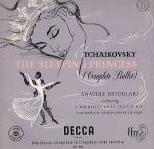
Though I do not agree with “The Record Guide” that Fistoulari’s “Swan Lake”, while “on the whole very competent, at times shows a tendency to go to sleep”, he does seem to obtain an extra degree of passion and commitment from the Paris Conservatoire Orchestra in his “
Sleeping Beauty”, almost but not quite to the same extent as his “Nutcracker” selection with the same band. It is in any case a very fine traversal, unfailingly convincing in its tempi and with much delightful solo work from the orchestra (LXT 2762-3). In the early 1960s Fistoulari recorded an LP selection with the LSO which is currently available as a filler to the complete “Nutcracker” under Dorati.
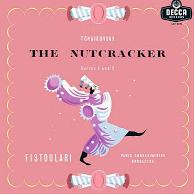
It is strange to read today, in the once-so-revered “The Record Guide” (1955 edition) that “
Casse-Noisette is no longer to be seen complete in this country – it used to be given at Sadler’s Wells before the war”. This, presumably, is why Fistoulari was engaged to conduct only a selection of
The Nutcracker, with the Paris Conservatoire Orchestra, instead of the hypothetically complete versions he set down of the other Tchaikovsky ballets.
The first side has the traditional suite, sharply characterized and generally crisp, though the
Valse des Fleurs is on the steady side. On the second side Fistoulari presents his own “Suite no. 2”, drawing upon the larger, more symphonically-developed numbers. He conducts here with a greater freedom and spontaneity than I found in any other of his records, displaying the sort of gut commitment that is the touchstone of great Tchaikovsky conducting. The Act 2 Scene – the piece with a melody that is “simply” a descending scale – is given with overwhelming impact. Good-to-excellent as Fistoulari invariably is, this is something special (Decca
LXT 2611/LXT 5371, rec. 21-23 June 1951).
And now?
I thought, before I embarked on this article, that I had gathered together a goodly number of Fistoulari recordings. I am little amazed, though, at just how many there are that I haven’t heard. But, while I certainly hope to hear the remainder one day, I do not think they will affect the impression I have already formed, since they would be more of the same – more accompaniments, more short, colourful orchestral pieces, more ballet. Only the Liszt tone poems and the longer Tchaikovsky works call for interpretative skills not tested by the repertoire I have heard.
The conclusion must in any case be that Fistoulari’s gifts were considerable. It is interesting, too, that, despite his having made his home in the United Kingdom, his finest discs seem to have been made with orchestras from continental Europe – the one-off with the Amsterdam Concertgebouw, the handful with the Berlin RIAS and the considerable series with the Paris Conservatoire Orchestra. In numerous discs from the 1950s this latter band has presented an image of amiable sloppiness, oh-so-characterful and oh-so-French, but ragged and undisciplined. Nobody has ever reported that Fistoulari was a martinet, yet he invariably has that orchestra playing with sizzling articulation, rhythmic alertness and real bite.
John Amis concludes his obituary by recalling that “The last time I saw him was in Lugano in the late Sixties, conducting Shostakovich’s Fifth Symphony with the Radio Svizzera; he made that fifth-rate orchestra sound almost first-rate – the work of a very considerable talent”.
The RTSI of Lugano, like most Radio stations in continental Europe, generally preserves its recordings. There is therefore a sporting chance that this performance survives. So what about it, someone? There is no comparable work in Fistoulari’s official discography. A few retrievals of that kind would extend our knowledge of him very considerably indeed.
Christopher Howell
